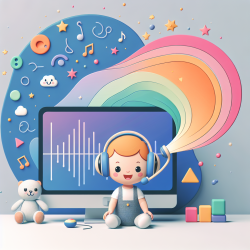In the past decade, significant strides have been made in understanding how sound localization skills develop in infants. The research article "Recent Advances in the Behavioral Study of Infant Audition: The Development of Sound Localization Skills" by Barbara A. Morrongiello and Andrew Gotowiec provides valuable insights into this area. As a practitioner providing online therapy services to schools, you can leverage these findings to enhance your therapeutic approaches.
Key Findings from the Research
- Infants can localize sounds along the horizontal axis from birth, with systematic improvements observed between 6 and 18 months of age.
- Vertical sound localization is more challenging for infants and develops more slowly than horizontal localization.
- High-frequency sounds (greater than 5 kHz) are crucial for accurate vertical localization.
- Otitis media with effusion (OME) can negatively impact sound localization due to binaural imbalance, but the effects are typically reversible.
- The precedence effect, an auditory illusion that helps in sound localization in reverberant environments, develops between 2 and 6 months of age.
Implementing Research Findings in Online Therapy
Incorporate Horizontal and Vertical Localization Exercises
Given that infants show improvements in horizontal localization from birth, you can incorporate exercises that stimulate this ability. Use sound sources that move laterally and encourage infants to turn their heads towards the sound. For older infants, introduce vertical localization exercises by using sounds from above or below to help them develop this skill.
Utilize High-Frequency Sounds
Since high-frequency sounds are essential for vertical localization, include a variety of high-pitched sounds in your therapy sessions. This will help infants develop their ability to localize sounds along the vertical axis more accurately.
Monitor and Address Otitis Media with Effusion (OME)
Be vigilant about the presence of OME in infants, as it can disrupt sound localization. If an infant has a history of OME, consider scheduling follow-up sessions to reassess their localization abilities and provide targeted exercises to address any lingering effects.
Incorporate the Precedence Effect in Therapy
The precedence effect helps in localizing sounds in complex auditory environments. You can create exercises that mimic this effect by presenting sounds with slight delays from multiple sources. This will help infants develop their ability to focus on the primary sound source in reverberant settings.
Encouraging Further Research
While implementing these strategies can significantly enhance your therapy sessions, it is also crucial to stay updated with ongoing research in this field. Encouraging further research and staying informed about new findings will ensure that your therapeutic approaches remain effective and evidence-based.
Conclusion
By integrating the findings from the research on infant audition into your online therapy sessions, you can provide more effective and targeted interventions. This will not only enhance the developmental outcomes for infants but also ensure that your therapy practices are grounded in the latest scientific evidence.
To read the original research paper, please follow this link: Recent Advances in the Behavioral Study of Infant Audition: The Development of Sound Localization Skills / Les progrs rcents dans l'tude du comportement de l'audition de l'enfant: le dveloppement des capacits de localisation des sons.










